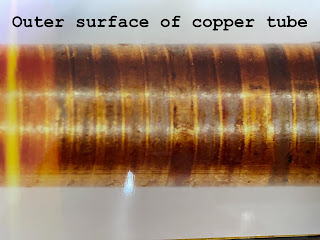Introduction
Flow-accelerated corrosion (FAC) is metal loss through the dissolution of the protective oxide film by localized turbulence in water or wet steam piping system [1]. The metal corrosion is accelerated by the continuous erosive destruction of the protective layers. Under certain water chemistry, fluid velocity, and operating conditions, FAC can cause internal wall thinning of condensate and feed-water piping, heater drip and drain lines, and other carbon steel piping [2]. In some cases, this thinning has led to catastrophic failures and fatalities.
Fig.1 Boiler tube for failure analysis
In this case study, the failed component was the evaporator tube, which had been in service for nearly 4 years. The tube was the component of the evaporator outlet of the low-pressure steam in the heat recovery steam generator (HSRG). The tube was used for feeding water to the continuous process for boiler. During operation, it was exposed to hot water (120-200 C) and the pressure of 4-6 Bar (depends on the flow rate). The water solution has pH around 8.4-9.4, conductivity 3.8-7.5 micro-S/cm, silica content 4-20 microgram/l and iron content 3-24 microgram/l. The fluid flow velocity was about 0.3 M/s (flow rate 0.217 kg/s). The liquid ammonia was added into the water to control the pH value, and the hydrazine was also added to reduce oxygen content. The outer part of the tube was exposed to exhaust gas from the gas turbine (520 C and atmospheric pressure). The tube material was made of carbon steel grade ASTM SA-178A, which was 1.5 inches diameter and 0.094 inch thick. One section of the tube was replaced with a new ASTM SA106B steel tube by welding.
Fig.2 Longitudinal cross cut showing metal loss patterns
Fig.3 Horse shoe patterns, indicative of FAC was found on the inner tube surface
Fig.4 Macrostructure showing the wave patterns
Suggestions
Most cases of erosion corrosion can be minimized by
1. Redesigning or replacing the bended section with a larger radius tube.
2. Controlling the weld bead inside the tube during and after welding process.
3. Operating under homogenization of the water temperature and flow rate.
4. Maintaining the cleanliness of the fluid.
5. Selecting the material with high erosion corrosion resistant
6. Choosing the same grade and diameter of the pipe to be joint together
7. Avoiding overfeed of hydrazine and control the feed rate to match the water rate.
References:
[1] R.B. Dooley, V.K. Chexal, 2000, “Flow-accelerated corrosion of pressure vessels in fossil plant”, International Journal of Pressure Vessels and Piping, Vol.77, pp.85-90.
[2] Crispin Hales, Kelly J. Stevens, Philip L. Daniel, Mehrooz Zamanzadeh, Albert D. Owens., 2002, “Boiler feedwater pipe failure by flow-assisted chelant corrosion”, Engineering Failure Analysis, Vol.9, pp.235-243.
[3] R.D. Port, 1998, “Flow Accelerated Corrosion”, Nace International, paper no.721.









ไม่มีความคิดเห็น:
แสดงความคิดเห็น